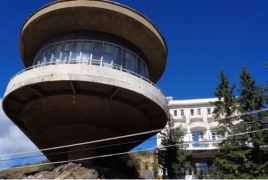
British writer and journalist Owen Hatherley in a new article published on The Calvert Journal explores the remarkable history of Lake Sevan Writers’ Resort — a monument to the avant-garde dreams of the 20th century, this icon of Khrushchev Modernism is now facing an uncertain future
The site where the Writers’ Resort stands was originally an island in the lake, which became a peninsula when the water level was lowered for irrigation works in the 1930s. On the top of the peninsula’s steep hill is a ninth-century monastery, whose conical churches were made from the same harsh red and brown rocks as the landscape around. But the craggy aesthetic of the monastery didn’t influence architects Gevorg Kochar and Mikael Mazmanyan when they were commissioned to design a Writers Resort here in 1932.
In the mid-1920s, Kochar and Mazmanyan had been involved with the “left art” group Standard, an Armenian equivalent to communist avant-garde groups like LEF in Moscow and New Generation in Kharkiv. Their ideas were opposed to those who tried to create a “national school” in Armenian Soviet architecture
In 1937, not very long after the Resort hosted its first guests, Kochar and Mazmanyan were arrested and deported to the Arctic Circle, about as far from Lake Sevan as it’s possible to imagine. They would spend 15 years in Norilsk before they were “rehabilitated” after the death of Stalin.
It’s at this point that the story’s extremely unusual second act begins. In the early 60s, after his return to Armenia, Kochar was commissioned to design a new café wing for the Resort he’d designed 30 years earlier. The result is astonishing. While in the 1920s and 1930s, Soviet avant-garde architects had dreamed of using new technology to create almost weightless, precipitous structures of concrete and glass, what they actually built was the simpler, boxy modernism you can see in the 1932 resort. In 1963, Kochar actually got to build an avant-garde dream project. A long, curved glass volume is cantilevered right out above the rocks overlooking the lake, so far that you could park trucks underneath it, with the whole construction balanced on one thick concrete leg. It’s a genuinely spectacular vindication of the ideas about “local” modernism that Kochar and Mazmanyan had advanced in the 20s: completely integrated into its site, a sentry nestled above the rocks, allowing café customers panoramic views of the lake and the mountains. It has no sentimentality towards the monastery or the historic architecture around, preferring instead a futurist aesthetic suited to a country that was then sending people into space. Since the 60s — and especially in the last few years — the building has become an oft-photographed emblem of the modernism of the Khrushchev Thaw, here given particular poignancy because it was the creation of one of Stalin’s victims, coming back to complete the unfinished business of the 1920s.
Now the surroundings are messy — the landscape could hardly be ruined no matter how hard developers tried, people still holiday here, mainly from within Armenia itself, and the caravans are as oddly fitting as the new hotel buildings are typically post-Soviet gimcrack. But the Resort clearly needs repair and renovation. The current plans are ambitious. A grant as part of the Getty Foundation’s “Keeping it Modern” programme has funded an investigation into the building’s fabric by architects from Helsinki’s Alvar Aalto Foundation; current proposals by Armenian designers Urbanlab envisage this as a pilot project to show what is possible in the renovation of Soviet Modernist buildings, which are habitually either mutilated in clumsy “Euro-renovations” or demolished in favour of approximations of medieval churches.
But if you go to Sevan now, before these plans are put in place, you’ll find something entirely unique: a cheap hostel on a mountain lake, a modern art gallery and a living museum of Soviet tragedy and achievement unlike any other.

